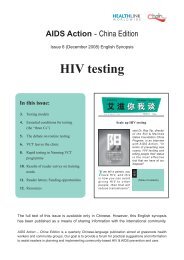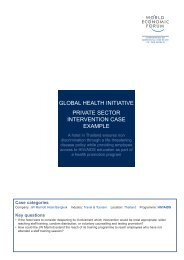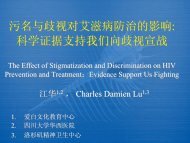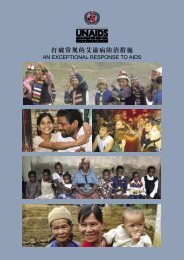S<strong>in</strong>gapore <strong>and</strong> Hong Kong. Therewere <strong>in</strong>tense focal epidemics <strong>in</strong> thelate 1980s among IDU populations<strong>in</strong> Australia, Thail<strong>and</strong>, northeastIndia, several prov<strong>in</strong>ces <strong>in</strong>Ch<strong>in</strong>a, Malaysia, Myanmar,Vietnam <strong>and</strong>, most recently, Nepal.Major heterosexual epidemics, primarilydriven by sex work, havereached seroprevalence levels of onepercent to three percent among the15- to 49-year-old population <strong>in</strong>Cambodia, Myanmar, Thail<strong>and</strong><strong>and</strong> several states <strong>in</strong> India.Epidemiological studies over thepast decade also have shown that<strong>HIV</strong> epidemics among MSM,IDUs <strong>and</strong> heterosexual populationsmay develop <strong>in</strong>dependently of eachother, depend<strong>in</strong>g upon the sexualbridges between these populations.<strong>HIV</strong> prevalence has rema<strong>in</strong>edrelatively low (less than .01 percent)<strong>in</strong> the total 15- to 49-year-old age group <strong>in</strong>some develop<strong>in</strong>g countries <strong>in</strong> the region, despite comparablyhigh levels of other STDs <strong>in</strong> segments of thispopulation. Even among CSWs <strong>in</strong> the Philipp<strong>in</strong>es <strong>and</strong>Indonesia, <strong>HIV</strong> <strong>in</strong>fection levels have rema<strong>in</strong>ed m<strong>in</strong>imal.As we come to better appreciate the quantitativedifferences <strong>in</strong> sexual behavior—as <strong>in</strong>fluenced by culture<strong>and</strong> religion—between these countries <strong>and</strong> thosethat have experienced severe sexual spread, it shouldbe <strong>in</strong>creas<strong>in</strong>gly possible to make longer term predictionsof the trends <strong>in</strong> the spread of the epidemic overthe next several decades.From a regional perspective, the ultimate impact of<strong>HIV</strong>/<strong>AIDS</strong> <strong>in</strong> this region will be determ<strong>in</strong>ed by theextent of ongo<strong>in</strong>g epidemics <strong>in</strong> a number of key countries:Cambodia, Myanmar, Thail<strong>and</strong>, <strong>and</strong>, because oftheir population size, Indonesia, India <strong>and</strong> Ch<strong>in</strong>a.■The epidemics <strong>in</strong> this region feature:An exceed<strong>in</strong>gly complex epidemic <strong>in</strong> India that<strong>in</strong>volves multiple epidemic foci, such as outbreaksamong IDUs <strong>and</strong> extensive <strong>HIV</strong> spread amongfemale CSWs <strong>and</strong> their clients <strong>in</strong> several regions.F igure 4<strong>HIV</strong> Prevalence for General Population bySex, 1995–1996, Zambia, Urban<strong>HIV</strong> Prevalence (%)■■FemalesMales15-19 20-24 25-29 30-39FylkenesSubstantial heterosexual epidemics with comparablyhigh levels of <strong>HIV</strong> <strong>in</strong> pregnant women <strong>in</strong>Thail<strong>and</strong>, Cambodia <strong>and</strong> parts of Myanmar, withconcentrations among IDUs <strong>and</strong> CSWs <strong>in</strong> othercountries, such as Vietnam.Ongo<strong>in</strong>g low <strong>HIV</strong> prevalence (less than 0.1 percent)<strong>in</strong> the total 15- to 49-year-old population <strong>in</strong>some countries. In the Philipp<strong>in</strong>es, <strong>HIV</strong> surveillancehas found only a few cases of <strong>HIV</strong> <strong>in</strong>fectionamong female CSWs, male STD cl<strong>in</strong>ic patients<strong>and</strong> MSM. Indonesia likewise has reported only asmall number of <strong>AIDS</strong> cases <strong>and</strong> low levels of <strong>HIV</strong><strong>in</strong>fection.T HE EPIDEMICS OF LATIN AMERICAAND THE CARIBBEANThere are two dist<strong>in</strong>ct epidemics <strong>in</strong> Lat<strong>in</strong> America<strong>and</strong> the Caribbean, one <strong>in</strong> the isl<strong>and</strong> <strong>and</strong> coastal countriesof the Caribbean, another <strong>in</strong> ma<strong>in</strong>l<strong>and</strong> SouthAmerica. With eight percent of the world’s population,the Lat<strong>in</strong> American <strong>and</strong> Caribbean region is home to<strong>HIV</strong>/<strong>AIDS</strong> <strong>Prevention</strong> <strong>and</strong> <strong>Care</strong> <strong>in</strong> <strong>Resource</strong>-Constra<strong>in</strong>ed Sett<strong>in</strong>gs XI
F igure 5<strong>HIV</strong> Seroprevalence for Commercial SexWorkers <strong>in</strong> Selected Urban Areas of Asia: 1987–1999<strong>HIV</strong> Seroprevalence (%)60Phnom PenhMumbai (Bombay)40200Katm<strong>and</strong>uNortheastCalcuttaNorthCentralSouthernThail<strong>and</strong>Ha NoiHo Chi M<strong>in</strong>h1987 1989 1991 1993 1995 1997 1999Source: U.S. Bureau of the Census, <strong>HIV</strong>/<strong>AIDS</strong> Surveillance Data Base, 2000.4.9 percent of all people liv<strong>in</strong>g with <strong>HIV</strong>/<strong>AIDS</strong>(PLHA) at the beg<strong>in</strong>n<strong>in</strong>g of the 21st century. Thereare close to 1.3 million PLHA <strong>in</strong> Lat<strong>in</strong> America <strong>and</strong>another 360,000 <strong>in</strong> the Caribbean. Because of thewide diversity of <strong>HIV</strong> epidemics, these regional figuresmask huge differences <strong>in</strong> epidemic levels <strong>and</strong> patternsof transmission.Although the Caribbean is geographically small, ithas a total population of more than six million. Someparts of Haiti <strong>and</strong> the Dom<strong>in</strong>ican Republic have <strong>HIV</strong>prevalence rates higher than any other country <strong>in</strong> theworld outside of sub-Saharan Africa. <strong>HIV</strong> test<strong>in</strong>g ofpregnant women attend<strong>in</strong>g antenatal cl<strong>in</strong>ics suggeststhat at least one <strong>in</strong> 12 adults between ages 15 <strong>and</strong> 49is liv<strong>in</strong>g with <strong>HIV</strong>. Guyana has also been hit harshlyby <strong>HIV</strong>. In 1996, 7.1 percent of pregnant Guyanesewomen tested for <strong>HIV</strong> were found to be <strong>in</strong>fected.Outside the Caribbean, the hardest hit area <strong>in</strong> thisregion is Central America. In Honduras, Guatemala<strong>and</strong> Belize, the epidemic appears to be heterosexuallydriven <strong>and</strong> <strong>in</strong>creas<strong>in</strong>g. In San Pedro Sula, the <strong>HIV</strong> epicenter<strong>in</strong> Honduras, <strong>HIV</strong> <strong>in</strong>fection among pregnantwomen has fluctuated between two percent <strong>and</strong> fivepercent for several years. In Costa Rica, on the otherh<strong>and</strong>, <strong>HIV</strong> is concentrated among MSM <strong>and</strong> seems tobe conta<strong>in</strong>ed at relatively low levels.XII <strong>HIV</strong>/<strong>AIDS</strong> <strong>Prevention</strong> <strong>and</strong> <strong>Care</strong> <strong>in</strong> <strong>Resource</strong>-Constra<strong>in</strong>ed Sett<strong>in</strong>gs
















